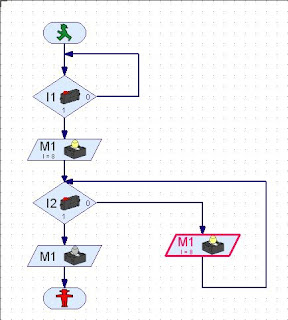
Above is the program that I made for one part of this activity.
1. Examine the wire diagram on the mini switch and describe how the diagram relates to the concepts of normally open and normally closed. A normally open switch is a switch that starts out as 0, and when pressed it goes to 1. A normally closed switch is the opposite of that, starting out at 1 and then when pressed, 0. In the program above, both switches were normally open. On pressing the first switch, the lamp turns on and waits for input from the second switch. When that's pressed, the lamp shuts off and the program ends.
2. If computers only understand digital signals, then how is a computer able to interpret the analog signal coming from the interface? The computer is able to understand an analog signal as a digital signal, but it won't be as specific as an analog signal. For example, if you were using an analog joystick rather than a directional pad for moving something that would only accept digital signals, how far you moved an analog joystick wouldn't affect how fast it would move. It would act as if it were digital.
3. Why does resistance decrease as the NTC Resistor becomes warmer? I believe that NTC Resistors work by taking out energy in heat on the resistor to weaken the current, so if it were already heated up, there wouldn't be much more heat energy to build up and waste.




 1. Something engineering related that I have a "passion" for could be designing maps for video games. Above is the HAMMER Editor for Valve's Source Engine SDK (Software Development Kit), the main tool I have used to create maps.
1. Something engineering related that I have a "passion" for could be designing maps for video games. Above is the HAMMER Editor for Valve's Source Engine SDK (Software Development Kit), the main tool I have used to create maps.


